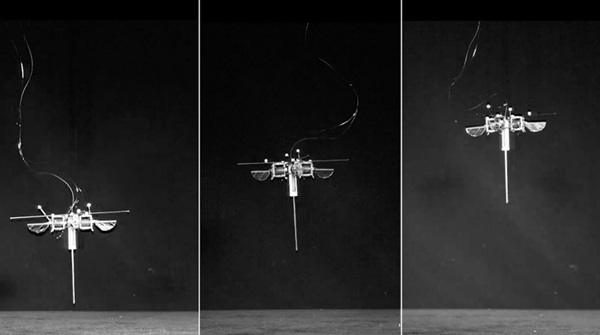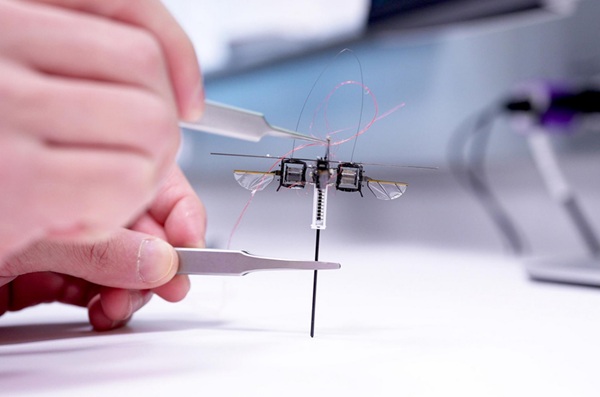Dômyselný robot s krídlami vyskočí tam, kde sa iné boja ísť
- Autor:
- Roman Mališka
- Zverejnené:
- 17. 4. 2025
- Hodnotenie:
- Už ste hlasovali.
Lietajúce roboty majú oproti svojim pozemným náprotivkom niekoľko veľkých výhod, ale rozhodne nie sú veľmi energeticky úsporné. Experimentálny nový robot rieši tento kompromis použitím mechanizmu s pomocou krídel, ktorý mu umožňuje skákať namiesto chôdze alebo lietania v tradičnom zmysle slova.
Robot, vyvinutý tímom vedcov z Massachusettskej technickej univerzity (MIT), Hongkonskej univerzity a Mestskej univerzity v Hongkongu, váži menej ako 1 gram a meria niečo vyše 5 centimetrov. Je pritom vybavený vertikálne orientovanou pružinovou tyčou z uhlíkových vlákien, ktorá funguje ako skákacia noha podobná pogo tyči.
Na vrchu tela sa nachádzajú štyri mávajúce krídla inšpirované hmyzom, ktoré sú pohybované elektricky aktivovanými umelými svalmi. V súčasnej podobe je robot pevne pripojený k externému zdroju energie a riadený externým systémom sledovania pohybu.
Keď robot prvýkrát dopadne na zem, jeho pružina v nohách sa pri náraze stlačí, čím sa uloží energia. Táto energia sa potom uvoľní, keď sa pružina odrazí a vymrští robota do vzduchu. Jeho krídla sa pohybujú, aby poskytli dodatočný vztlak, čo mu umožňuje vyskočiť až 20 centimetrov a zároveň sa pohybovať bočne rýchlosťou až 30 centimetrov za sekundu. Napriek tomu stále spotrebuje oveľa menej energie, ako keby ho krídla skutočne držali vo vzduchu.

Na vrchole skoku systém sledovania pohybu identifikuje ďalšie miesto pristátia robota, identifikuje jeho uhol a typ terénu. Riadiaci algoritmus na pripojenom počítači potom vypočíta rýchlosť a uhol, pod ktorým bude musieť robot pristáť na tomto mieste, aby úspešne vykonal svoj ďalší skok. Krídla sa teda používajú na úpravu jeho orientácie pri zostupe, aby sa zabezpečilo splnenie týchto kritérií.
Týmto spôsobom dokáže robot ľahko prekonávať prekážky a prechádzať rôznymi typmi drsného a / alebo šikmého terénu, ktorý by brzdil kolesové alebo kráčajúce roboty. Doteraz sa mu úspešne podarilo prekonať trávu, ľad, mokré sklo, nerovnú pôdu a dokonca aj dynamicky nakláňajúcu sa plochú dosku. Zároveň však testy ukázali, že robot spotrebuje o 64 % menej energie ako konvenčný robotický dron na prelet rovnakej vzdialenosti.

Keďže je robot taký energeticky úsporný, vedci teraz plánujú vybaviť ho vlastnou palubnou batériou a systémom sledovania pohybu. Mohol by byť tiež vybavený ďalšími senzormi, ktoré by sa jedného dňa mohli použiť pri úlohách, ako je hľadanie pozostalých na miestach katastrof alebo prieskum nebezpečného prostredia.
Článok o výskume, ktorý viedli Yi-Hsuan Hsiao, Songnan Bai a Zhongtao Guan, bol nedávno publikovaný v magazíne Science Advances.

